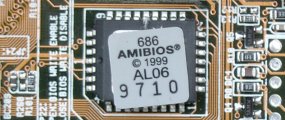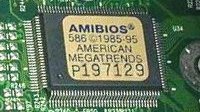
Your BIOS will most likely be stored in a 32-pin chip, which can typically be identified by a silver or gold sticker that shows the name of the BIOS company – such as AMIBIOS, AWARD or Phoenix – and a code that indicates the version of code it contains.
If it’s rectangular in shape, it’s what is known as a DIP (Dual In-line Package) chip. Older motherboards may have 28-pin DIP BIOS chips.

If your BIOS chip is square with connections on all four sides, it is in a PLCC (Plastic Leaded Chip Carrier) package. A locating notch indicates the orientation of pin 1.
Socketed PLCC chips are a little more tricky to remove than DIP chips and are best tackled using a specially designed removal tool.

If you have a DIP or PLCC chip that’s actually soldered to your motherboard, you’re out of luck – updating your BIOS is not an option!